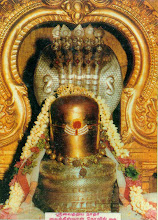How shall we evaluate this work by a saint on the lives of saints? A wise saying in Sanskrit echoes what we mean by ‘Only a Shakespeare can understand Shakespeare.’ Gurudev’s secondless devotion to God is amply reflected in the inspiring presentation of these great lives, simple, lucid and touching. We could have had none better qualified for it. Gurudev’s handling of it adds lustre to the illustrious lives.
There have been many ‘intellectuals’ even in India who have looked down upon the path of Bhakti (devotion) as something inferior to Jnana (wisdom). Their short-sightedness becomes at once apparent when we study the lives of the great Four Teachers (Appar, Sundarar, Manickavachagar and Sambandar) and realise that these great Jnanis, too, were great Bhaktas who loved to visit the temples and sing the glories of the Lord. Look at the humility of Appar who carried Sambandar’s palanquin: this reminds us of Gurudev’s own inimitable humility. It is not born of the weakness of the ignorant: but it is the culmination of true knowledge!
How shall we understand the wonderful spirit of renunciation that characterised the lives of many royal Nayanars, if we regard them as weaklings? They had understood the true nature of the world, and wanted only God. Can we not draw a parallel in our own divine Master who, similarly, renounced a royal life of a doctor in Malaya, in exchange for poverty and the begging bowl? Love of the Lord cuts at the very root of our attachment to this world, and snaps all worldly ties, to father, mother, son, wife or relatives. As the stories of the Nayanars illustrate, the devotee is ever ready to renounce all, in favour of devotion to Lord Siva. Chandesvara Nayanar, in his complete absorption in His worship, could inflict a mortal blow on his own father: but, that was because he saw not his father, but an obstacle to Siva Puja. When Arivattaya Nayanar found, for instance, that his weak body was getting unfit to carry on His worship, he was ready to cut his own throat. If Murkha Nayanar chose to gamble and even resort to violence to carry out his vow, Kannappa Nayanar would pull out his own eyes to serve the Lord! This great truth has been beautifully brought out again and again in these lives—love of God completely removes the devotee’s attachment to his own body. Who could even approach Siruthondar’s breath-taking devotion to the Lord and His devotees?
Let us also never forget that in the case of all the Nayanars devotion invariably meant expansion of the heart, and, therefore, service and charity.
It is essential that, in our study of these great lives, we take them as a whole: the sixty-three blending into one marvellous scripture on devotion. Else, it might lead to perversion. Perversion in spiritual path can be quite disastrous. Gurudev would often narrate, for example, the case of a wicked man who would catch fish in the Ganges, cut it and eat it, quoting (as a devil would) from the Gita: ‘Weapon cannot cut the Atma, which is immortal.’ The perverse intellect reads in the Gita, a sanction for the use of violence. Stories in which there is seeming use of violence by the Nayanars have to be read with this caution: we have to take them as allegories exhorting us to rout out the inner obstacles to our Sadhana, ruthlessly. The story of Eripatha Nayanar, for instance, should be taken as an exhortation for us to kill lust, anger and greed, the powerful impediments on our spiritual path which, in the twinkling of an eye wreck our worship of the Lord.
If we study the lives as a whole, we will not fail to note that Anaya Nayanar, and Pusalar Nayanar hold before us the ideal Para Bhakta, supreme exemplars of the highest form of devotion.
If we approach these saints with faith and devotion in our hearts, we shall grasp the message they have for us. We shall also understand why they gave such a great place to externals like the sacred ash, Rudraksha, etc. These symbols remind one constantly of God: and, when they are said to remove our sins, they remove our sinful tendencies, too, by constantly reminding us of God, and keeping evil out of our mind.
May we all walk the path of devotion and attain the Lord in this very birth is my humble prayer at the divine feet of our master. That is the only way in which we can repay the debt we owe him for what he has done for us.
Dust of Gurudev’s Feet
Venkatesananda






No comments:
Post a Comment